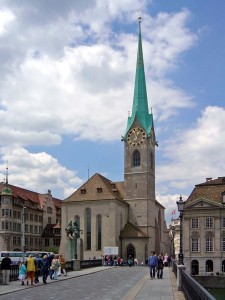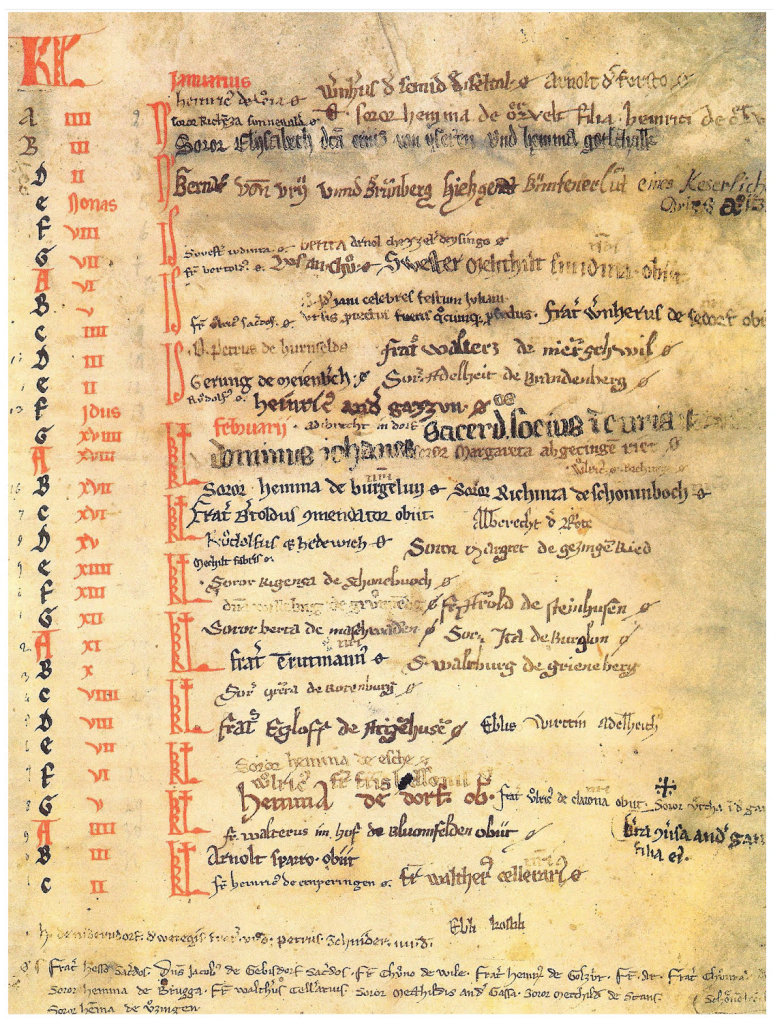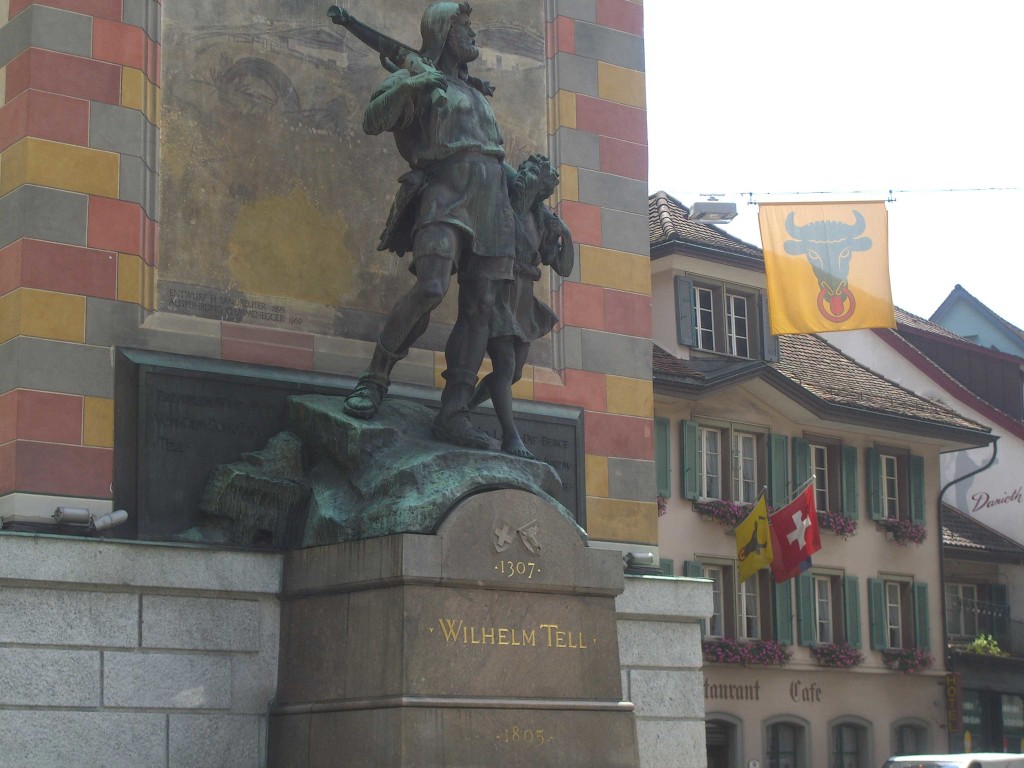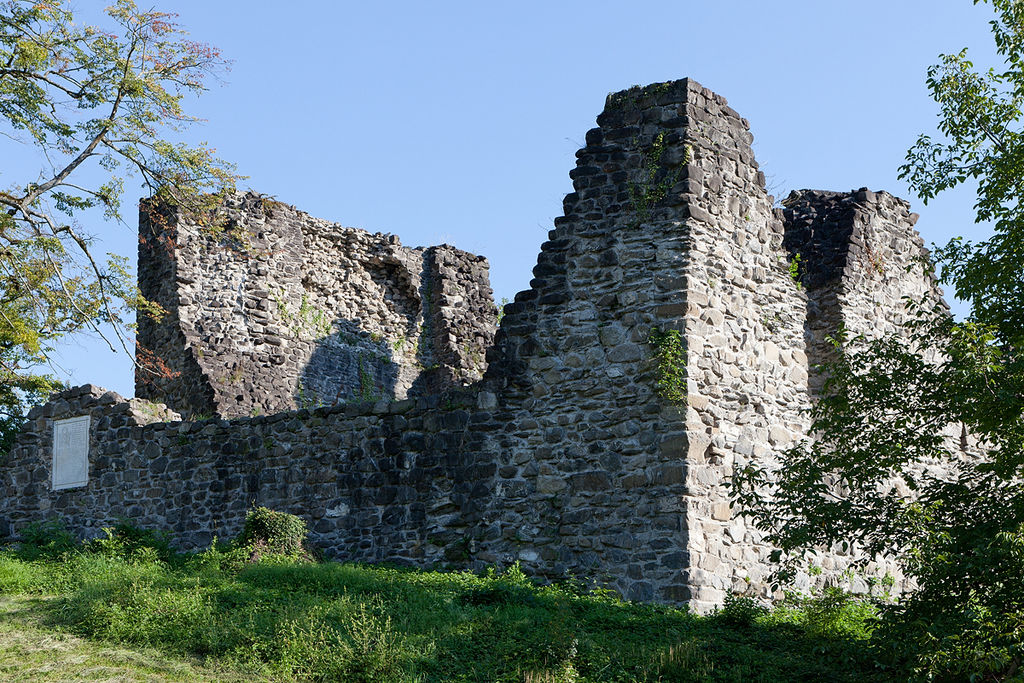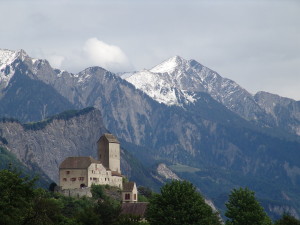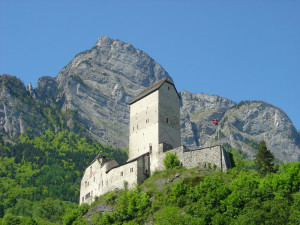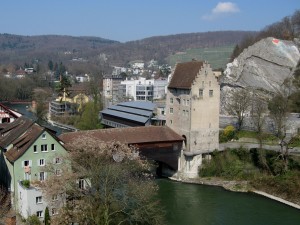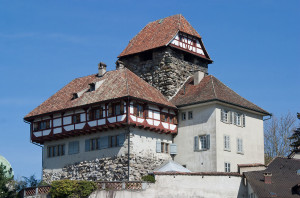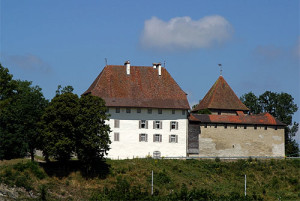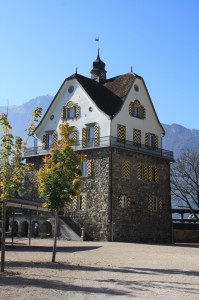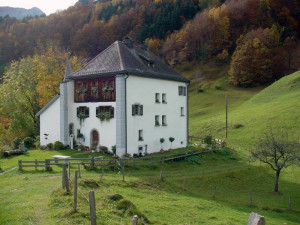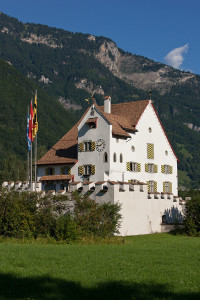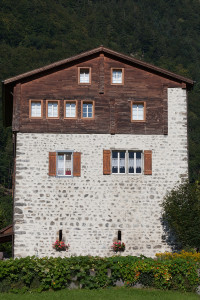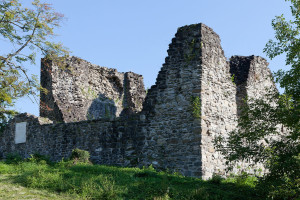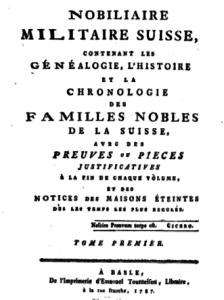Over the centuries, members of the Zumbrunnen family lived in at least eight different castles that are still standing today. Most of these castles can be visited by tourists. Here’s a brief history of the castles and the members of the Zumbrunnen family who lived in them.
Attinghausen Castle
Attinghausen Castle was the home of the Barons of Attinghausen, and the home in which Walter Zumbrunnen, the first Zumbrunnen, would have grown up. The castle was built perhaps as early as the 1000s or 1100s, although it is uncertain who the first owners of the castle were. It was expanded in the 1200s and was certainly the home of our relatives Werner Von Attinghausen through Johann Von Attinghausen.
The castle was abandoned around the time of Johann’s death in 1358. It’s possible the castle was ruined by a fire, either an accident or caused by an insurrection and that Johann died in the fire. It’s also possible that a fire happened after his death and the inheritors of the castle could not fix it.
By 1370, the castle was largely ruined; much or all of its grounds were in the possession of Walter Zumbrunnen (the great-great-great grandson of the original Walter Zumbrunnen). He likely purchased it from Johann’s sons-in-law who could not afford it. It’s unclear what happened to the ownership but by the 1400s, the Zumbrunnen no longer owned it.
The castle ruin is open to visitors.
Sargans Castle
Perhaps the most majestic of the castles in which the Zumbrunnen lived. The castle was built in stages beginning in the 1100s, with most of the modern structure completed in the 1500s. It sits in the town of Sargans in the Swiss canton of St. Gallen.
In 1483, the central cantons of Switzerland, including Uri, took control of the Sargans region. To administer their frontier territory they appointed a “landvogt,” often translated as “bailiff” or “reeve” to administer the region. The title was something akin to a colonial governor. While the exact role shifted over time, the basic structure was the same: the central cantons would take turns selecting their most capable magistrates to terms as landvogt. The landvogt would enforce the laws, and serve as a sort of military coordinator and ambassador back to the central cantons.
Four different Zumbrunnen men served as the landvogt of Sargans: Johann Zumbrunnen in 1466, Ulrich Zumbrunnen in 1494, Burkhard Zumbrunnen in 1663 and Josue Zumbrunnen in 1665. Apparently their names and Coat of Arms are on frescoes throughout the palace.
The castle is open to tourists. It is a restaurant and can also be booked as a wedding venue!
Bailiff’s Castle of Baden
The Swiss city of Baden (sometimes known as Baden bei Zurich, to avoid confusion with other cities named Baden) came under the protection of the central Swiss cantons in 1415. The castle sits on the right bank of the Linmat River which, as you can see in the picture, controlled passage on the bridge in the middle of town.
Johann Zumbrunnen II lived in the castle when he was appointed the landvogt of Baden in 1477. A successful term as a landvogt was one way to prove your administrative competence, and after his successful term as landvogt, Johann would eventually be appointed the landammann of Uri, the head of state for the entire canton.
Today the castle, also known as the Landvogteischloss Baden, is the town’s history museum and archive. It is open to tourists.
Frauenfeld Castle
The Canton of Thurgau lies along the Rhine River and Lake Constance in northeastern Switzerland, forming a border with Germany. Construction on the foundation was likely begun in 1244, with the castle developing over the coming centuries. Before its rescue by the central Swiss cantons, the population of this region was dominated by two of the most power-hungry families of Switzerland — the Counts of Kyburg and the Hapsburgs — who also occupied the castle.
The region at last came under the protection of the central Swiss cantons in 1460. The landvogt of Thurgau lived in this castle, which is located in the town of Frauenfeld. The castle was the residence of the landvogts beginning in 1534. One of the first landvogts to live in the castle was Mansuetus Zumbrunnen, beginning his term as landvogt in 1536. His son Johann Zumbrunnen was also landvogt, living in the castle beginning in 1564.
The castle is open to tourists today and serves as the canton’s history museum. It is also available weddings and quite reasonable rates.
Vaulruz Castle
Vaulruz, Switzerland is located in the region of Gruyere (famous for its cheese) in the French-speaking regions of Switzerland. A somewhat mysterious branch of the family lived in the Fribourg region in the early 1500s. I’m not sure how this branch is connected to the others, although for many years young Zumbrunnen men left their homes in Uri, to attend a Jesuit College in Fribourg.
Hans Zumbrunnen, from this branch of Fribourg Zumbrunnen, served as the bailiff of Vaulruz for most of the 1550s, and lived in this castle. The castle has its own website but I don’t read French well, and am not sure if it’s open to the public. It appears you can rent it for retreats and such.
Rudenz Castle
The castles of the landvogts were magnificent structures, but also served as administrative and military hubs. Over the centuries the Zumbrunnen inhabited a number of other castles that were more modest, and were used largely as residences.
One such castle is the Rudenz Castle, which sits just north of the town of Altdorf, with a majestic view out over Lake Lucerne. It was originally owned by Johann Von Attinghausen, who used it as a post for collecting customs duties along the trade-route. When he died without heirs it passed into the control of the Rudenz family, who also used it as their residence. The castle lost its strategic significance, but was purchased and restored by Johann Heinrich Zumbrunnen in the early 1600s, who used it as his residence. While the previous castles were essentially owned by the government and occupied as part of a job, this castle was owned by the Zumbrunnen family.
Sadly, we don’t still own this castle. By the early 1700s it was owned by the Epp family. Today the castle is owned by the town. The grounds of the castle are open to tourists, although I’m not sure if the interior of the building is.
Beroldingen Mini-Castle
Perhaps no family was more closely tied to the Zumbrunnen family than the Von Beroldingen family. The Von Beroldingen’s were originally servants of the Barons of Attinghausen but rose to prominence in their own right through trade, agriculture and military service, a testament to the (relatively) egalitarian nature of society in Uri.
The Von Beroldingen built this castle in 1500s, with a view out over Lake Lucerne. It is apparently located along an old mule path from Uri to Lucerne (though most trips from Uri to Lucerne would have been by boat). It is known by an unusual Swiss word “Schlossli” or “Schlösschen,” a diminutive for “Schloss” that I’ve translated here as mini-castle. It served as the family seat for many centuries.
At least three Zumbrunnen men may have come to the castle to court Von Beroldingen girls. Johan Zumbrunnen married Dorothea von Beroldingen, likely in the late 1400s (and possibly before this castle was built). In the 1600s, Anton Zumbrunnen married Maria Elizabetha Von Beroldingen and later in the 1600s Josue Zumbrunnen married Barbara Von Beroldingen. The latter two marriages certainly took place during the period in which the Von Beroldingen occupied this castle. This was thus a castle of our grandmothers more than our grandfathers. Like the Zumbrunnen family, the Von Beroldingen eventually immigrated away from Uri. Many other branches of the family survive to this day.
I’m not sure if the castle is open to visitors, although you can certainly hike to it.
A Pro Castle
The A Pro family (sometimes written as Apro) has an interesting history in Switzerland. They were originally from the Livinen Valley (or Leventina), part of the Italian-speaking region of Switzerland. Several Zumbrunnen men served as the landvogt of Livinen, helping to bring this region under the protection of Switzerland and fighting off the Dukes of Milan.
The A Pro family, so named because they came from a town called Prato, immigrated to Uri in the 14th century and became a prominent family despite their origin outside of central Switzerland. There prominence is a reminder that although Uri was German-speaking, it had heavy Italian influences.
In the 1500s, Dorothea Zumbrunnen, the daughter of Landammann Mansueutus Zumbrunnen, married Peter A Pro. Peter and Dorothea built the A Pro Castle in the 1550s, and the A Pro family owned the castle for nearly 400 years. Today the castle is open to the public as an upscale restaurant called the A Pro Schlossrestaurant (it has 4.5 stars on TripAdvisor!). It appears that you can walk through much of the castle if you go to the restaurant.
Schweinsberg Castle
A final castle of interest is the Schweinsberg Castle, located just several hundred yards from the Attinghausen Castle. As the Barons of Attinghausen grew in power and wealth in the 1200s and 1300s they built this second castle, which was likely occupied by members of the Attinghausen entourage, such as extended family (like the Zumbrunnen perhaps, although I have no proof of this) or prominent knights in their service.
At some point, the Attinghausen and Schweinsberg families had merged, possibly through marriage. For a time, the family went by both Attinghausen and Schweinsberg. Eventually, the family split in two, with one branch assuming control of lands near Bern and calling themselves only Von Schweinsberg. The other branch remained in Uri and called themselves only Von Attinghausen. Both of these branches were cousins of the Zumbrunnen. Though the Schweinsbergs and Attinghausen were in the higher nobility, and the Zumbrunnen were not, it’s likely that close family ties remained.
It is apparently unclear who owned the castle after Johann Von Attinghausen died, ending the Von Attinghausen line in Uri. Unfortunately, this castle is a private residence today and cannot be visited.
